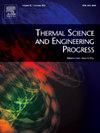Thermal performance of nanoparticle-infused PCMs in honeycomb-finned cavities for high-efficiency heat storage
IF 5.1
3区 工程技术
Q2 ENERGY & FUELS
引用次数: 0
Abstract
This study presents a novel dual-mode thermal enhancement strategy for latent heat thermal energy storage, combining nanoparticle augmentation and geometric optimization through honeycomb extended surfaces. A comprehensive numerical investigation is conducted to evaluate the melting performance of phase change materials (PCMs) enhanced with four different nanoparticles Al2O3, Cu, CuO, and graphene nanoplatelets (GnP) at volume concentrations of 2 %, 5 %, 8 %, and 10 %. Unlike prior works, this study provides a side-by-side comparison under identical boundary conditions, offering practical design insights for material geometry combinations. The phase change process is modelled using the enthalpy-porosity method, while natural convection is incorporated through the Boussinesq approximation. Performance metrics include liquid fraction evolution, melting time, and thermal field uniformity. Among all configurations, GnP at 10 % concentration yielded the best performance, reducing the melting time from 3000 s (pure PCM) to 1180 s without fins and further down to 950 s with honeycomb fins. The combination also resulted in a 98 % liquid fraction, temperature gradient reduction of over 60 %, and an increase in absorbed thermal energy from 170 kJ/kg to 218 kJ/kg. Other nanoparticles (Al2O3, Cu, CuO) showed moderate enhancements with melting time reductions ranging from 31 % to 43 %, depending on concentration and geometry. The results confirm that the synergistic integration of high thermal conductivity nanoparticles and geometrically optimized fins significantly enhances PCM thermal performance. These findings provide valuable design guidelines for advanced latent heat storage systems used in electric vehicle cooling, solar thermal collectors, and electronics thermal management.
蜂窝状翅片腔中注入纳米粒子的热性能研究
本研究提出了一种新型的双模热增强策略,将纳米颗粒增强与蜂窝扩展表面的几何优化相结合,用于潜热储能。在体积浓度为2%、5%、8%和10%的情况下,采用四种不同的纳米Al2O3、Cu、CuO和石墨烯纳米片(GnP)增强相变材料(PCMs)的熔融性能进行了全面的数值研究。与之前的工作不同,本研究提供了相同边界条件下的并排比较,为材料几何组合提供了实用的设计见解。相变过程采用焓孔法进行建模,而自然对流则通过Boussinesq近似进行模拟。性能指标包括液体馏分演变,熔化时间和热场均匀性。在所有配置中,10%浓度的GnP表现最好,将熔化时间从3000 s(纯PCM)减少到1180 s(无翅片),进一步减少到950 s(蜂窝翅片)。该组合还导致98%的液体分数,温度梯度降低60%以上,吸收的热能从170 kJ/kg增加到218 kJ/kg。其他纳米颗粒(Al2O3, Cu, CuO)表现出适度的增强,熔化时间减少了31%到43%,具体取决于浓度和几何形状。结果证实,高导热纳米颗粒与几何优化翅片的协同集成显著提高了PCM的热性能。这些发现为用于电动汽车冷却、太阳能集热器和电子热管理的先进潜热存储系统提供了有价值的设计指南。
本文章由计算机程序翻译,如有差异,请以英文原文为准。
求助全文
约1分钟内获得全文
求助全文
来源期刊

Thermal Science and Engineering Progress
Chemical Engineering-Fluid Flow and Transfer Processes
CiteScore
7.20
自引率
10.40%
发文量
327
审稿时长
41 days
期刊介绍:
Thermal Science and Engineering Progress (TSEP) publishes original, high-quality research articles that span activities ranging from fundamental scientific research and discussion of the more controversial thermodynamic theories, to developments in thermal engineering that are in many instances examples of the way scientists and engineers are addressing the challenges facing a growing population – smart cities and global warming – maximising thermodynamic efficiencies and minimising all heat losses. It is intended that these will be of current relevance and interest to industry, academia and other practitioners. It is evident that many specialised journals in thermal and, to some extent, in fluid disciplines tend to focus on topics that can be classified as fundamental in nature, or are ‘applied’ and near-market. Thermal Science and Engineering Progress will bridge the gap between these two areas, allowing authors to make an easy choice, should they or a journal editor feel that their papers are ‘out of scope’ when considering other journals. The range of topics covered by Thermal Science and Engineering Progress addresses the rapid rate of development being made in thermal transfer processes as they affect traditional fields, and important growth in the topical research areas of aerospace, thermal biological and medical systems, electronics and nano-technologies, renewable energy systems, food production (including agriculture), and the need to minimise man-made thermal impacts on climate change. Review articles on appropriate topics for TSEP are encouraged, although until TSEP is fully established, these will be limited in number. Before submitting such articles, please contact one of the Editors, or a member of the Editorial Advisory Board with an outline of your proposal and your expertise in the area of your review.
 求助内容:
求助内容: 应助结果提醒方式:
应助结果提醒方式:


